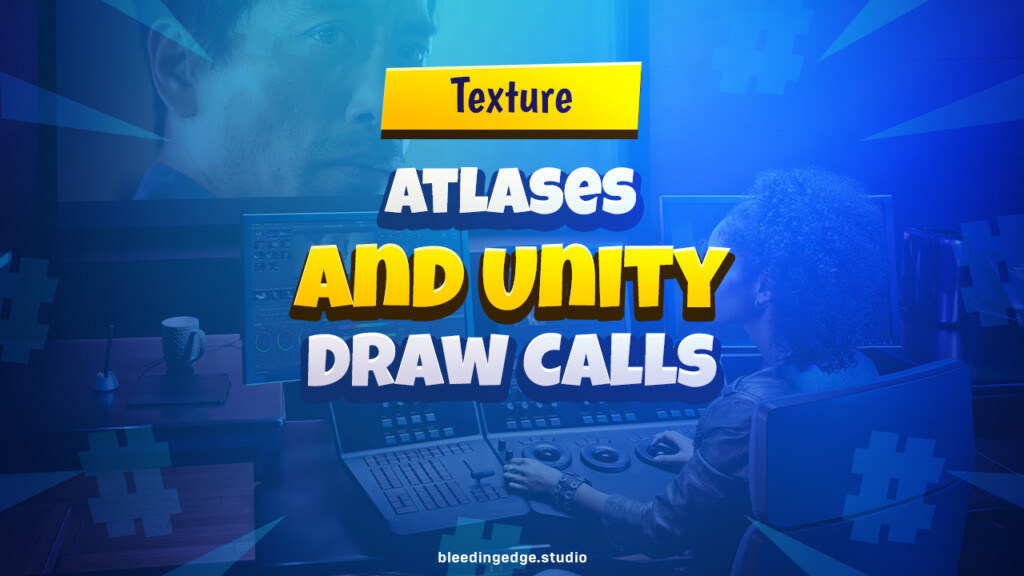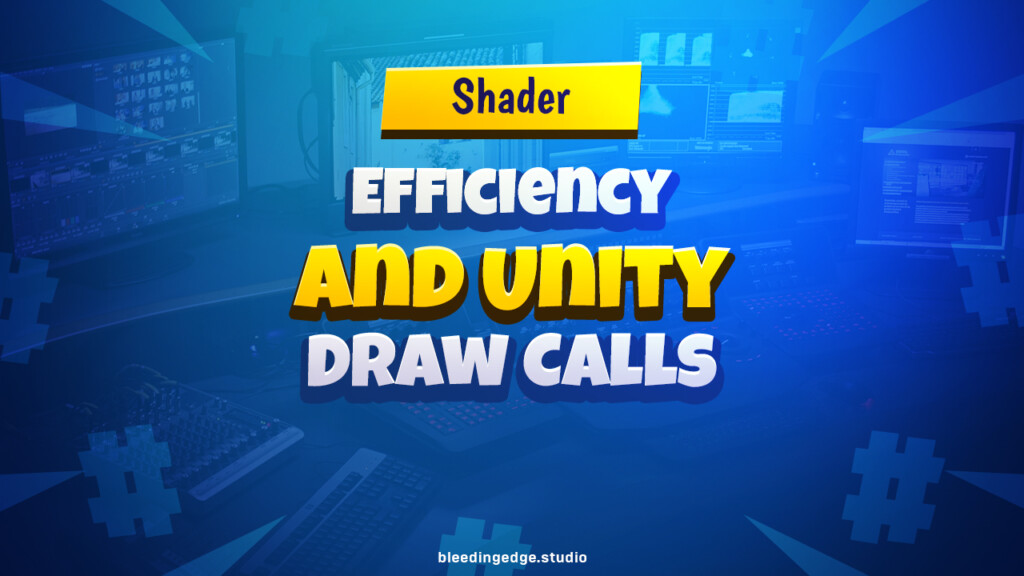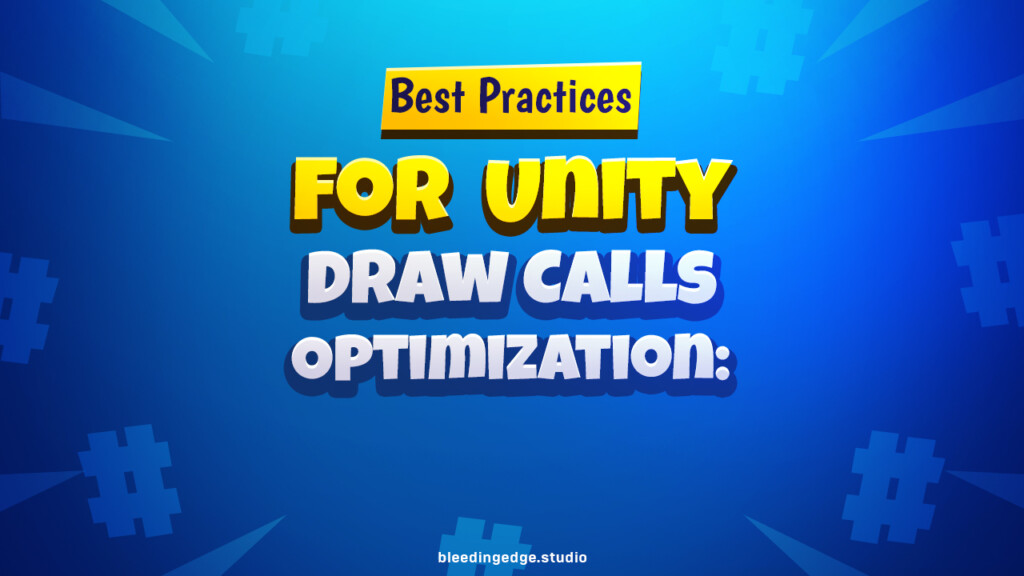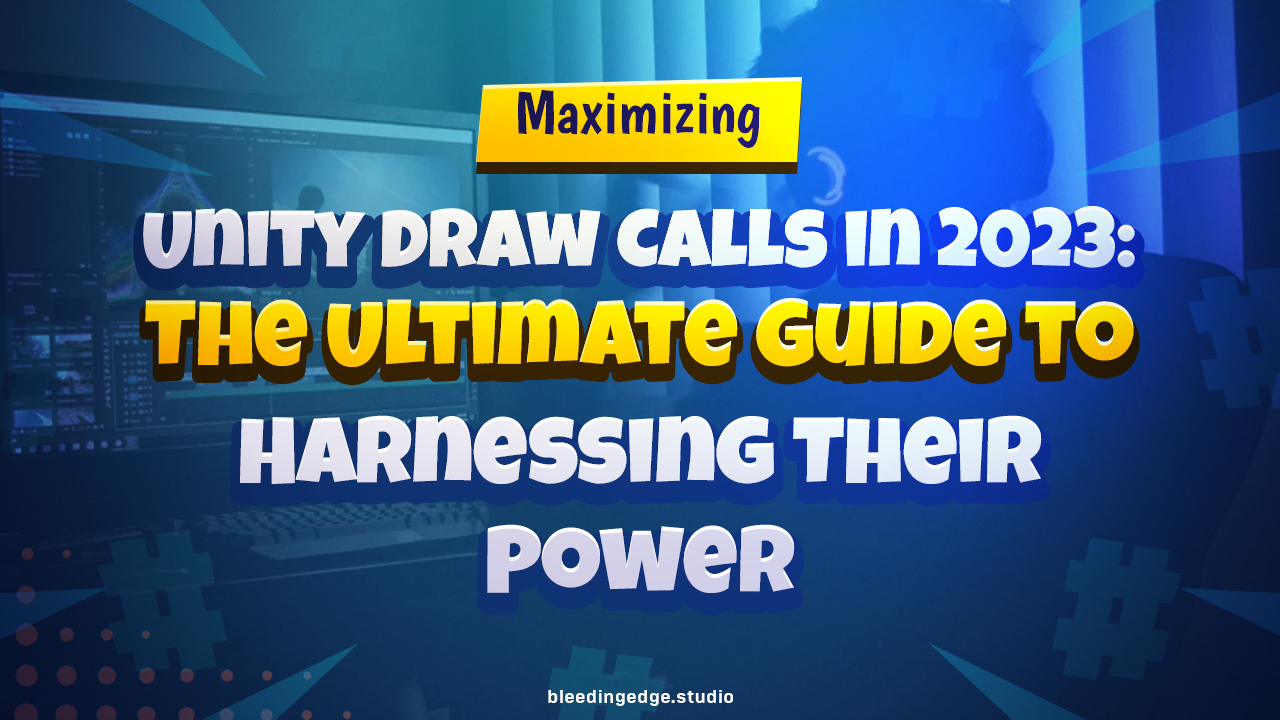Unleashing the Power of Unity Draw Calls: A Comprehensive Guide in 2023
Introduction:
Unity is a game development engine that professionals and enthusiasts use. One crucial aspect of optimizing performance in Unity is understanding and effectively managing to draw calls. Draw calls are pivotal in determining the efficiency and smoothness of rendering in your game. In this article, we will delve into the world of Unity draw calls, exploring their significance, techniques to optimize them, and best practices to enhance the overall performance of your Unity projects.
Table of Contents:
Understanding Draw Calls:
- What are Draw Calls?
- Role of Draw Calls in Rendering
- Importance of Draw Call Optimization
Draw Call Overhead:
- CPU vs. GPU Bottlenecks
- How Draw Calls Impact Performance
- Common Performance Issues
Draw Call Batching:
- Static vs. Dynamic Batching
- Benefits and Limitations of Batching
- Techniques for Efficient Batching
Texture Atlases and Draw Calls:
- Texture Memory and Performance
- Combining Textures with Atlases
- Benefits and Drawbacks of Texture Atlases
Using LODs and Culling:
- Level of Detail (LOD) Systems
- Culling Techniques for Efficiency
- Implementing LODs and Culling in Unity
Mesh and Material Optimization:
- Mesh Simplification and LODs
- Reducing Vertices and Overdraw
- Material Optimization Techniques
Scripting and Draw Calls:
- Dynamic Object Spawning
- Instantiating and Pooling Objects
- Managing to Draw Calls with Scripts
GPU Instancing:
- Introduction to GPU Instancing
- Setting up GPU Instancing in Unity
- Benefits and Performance Considerations
Shader Considerations:
- Shader Efficiency and Draw Calls
- Shader Variants and Performance
- Optimizing Shaders for Draw Calls
Profiling and Optimization:
- Profiling Tools in Unity
- Analyzing Draw Calls in Profilers
- Optimizing Draw Calls Based on Profiling Data
Best Practices for Draw Call Optimization:
- Minimizing Draw Call Overhead
- Maintaining a Balanced Scene
- Testing and Iterating for Performance
Let’s continue expanding on each section.
Draw Call Overhead:
CPU vs. GPU Bottlenecks: Draw calls can introduce CPU and GPU bottlenecks in your game’s performance. The CPU bottleneck occurs when the CPU spends too much time preparing and submitting draw calls to the GPU, limiting its ability to perform other essential tasks. On the other hand, the GPU bottleneck arises when the GPU becomes overwhelmed with draw calls, resulting in lower frame rates and visual lag in Unity draw calls.
How to Draw Calls Impact Performance: Each draw call incurs a certain amount of overhead, involving the CPU processing the command, preparing the data, and sending it to the GPU for rendering.

The more draw calls your game has, the more time the CPU spends on command processing, leading to decreased overall performance.
Common Performance Issues: Some common performance issues associated with draw calls include excessive dynamic batching, overuse of individual materials, and redundant draw calls. These issues can lead to increased CPU overhead, excessive memory consumption, and reduced frame rates. It is crucial to identify and resolve these issues through optimization techniques.
Texture Atlases and Unity Draw Calls: Texture Memory and Performance: Textures consume memory resources, and excessive texture usage can impact CPU and GPU performance.

Multiple draw calls involving different textures can result in frequent texture switching and decreased rendering efficiency. Texture atlases offer a solution by combining multiple textures into a single larger texture, reducing draw calls and optimizing memory usage.
Combining Textures with Atlases: Creating texture atlases involves arranging multiple textures into a single larger texture, optimizing the UV coordinates of the meshes, and adjusting the shaders accordingly. By utilizing texture atlases, you can reduce the number of draw calls required to render various objects and improve overall performance.
Benefits and Drawbacks of Texture Atlases: Texture atlases provide several benefits, including reduced draw call overhead, improved texture memory utilization, and minimized texture switching. However, it is essential to consider the drawbacks, such as increased texture memory usage and the need for additional effort in managing texture atlases when adding or modifying textures.
Mesh and Material Optimization:
Mesh Simplification and LODs: Mesh optimization techniques such as mesh simplification and Level of Detail (LOD) systems can significantly reduce the number of vertices and triangles in your scene. By dynamically adjusting the level of detail based on the distance from the camera, you can optimize draw calls by rendering simpler meshes when they are farther away, improving performance without compromising visual quality.
Reducing Vertices and Overdraw: High vertex counts and excessive overdraw can negatively impact performance by increasing the load on both CPU and GPU. To optimize draw calls, optimizing your meshes by reducing unnecessary vertices, eliminating redundant geometry, and minimizing overdraw through careful scene design and efficient material usage is crucial.
Material Optimization Techniques: Materials can significantly impact draw call performance. By combining multiple objects with similar materials into a single mesh, you can reduce the number of draw calls required. Additionally, avoiding expensive shader calculations, using shader variants judiciously, and using optimized shader techniques such as GPU instancing can further enhance draw call performance.
GPU Instancing: GPU Instancing is a technique that lets you render multiple instances of an object using a single draw call. By storing per-instance data in a buffer, the GPU can efficiently render multiple copies of an object, reducing the overall draw call count and improving performance.
Setting up GPU Instancing in Unity: Unity provides built-in support for GPU Instancing. You can use this feature by enabling GPU instancing on materials and shaders. Additionally, you can efficiently render instances with GPU instancing using the Unity API to populate the per-instance data buffer and configure the appropriate shader properties.
Benefits and Performance Considerations: GPU instancing offers several benefits, including reduced draw call overhead, decreased CPU and GPU load, and improved rendering performance. It is particularly effective when rendering many identical or similar objects in your scene. However, it’s important to know the limitations and potential trade-offs, such as increased memory usage for per-instance data and reduced flexibility for per-object modifications.
Shader Efficiency and Unity Draw Calls: Shaders play a crucial role in determining the visual appearance of objects in your scene.

Inefficient shaders can increase draw call overhead and impact performance. Optimizing shaders by minimizing unnecessary computations, using shader variants selectively, and considering the overall impact of shader complexity on draw call performance is important.
Shader Variants and Performance: Unity allows for shader variants and later versions of the same shader with variations in shader features and properties. While shader variants can enhance flexibility and provide customization options, excessive use of variants can lead to increased draw call overhead. Careful management and reduction of shader variants can improve performance by minimizing unnecessary draw calls.
Optimizing Shaders for Unity Draw Calls: To optimize shaders for draw calls, consider techniques such as reducing the number of texture lookups, minimizing the number of shader passes, utilizing shader LODs, and using efficient shader functions and calculations. By analyzing and optimizing shaders, you can significantly reduce the impact of draw call overhead and improve rendering performance.
Profiling and Optimization: Profiling Tools in Unity: Unity provides powerful profiling tools that allow you to know the performance of your game. The Unity Profiler lets you monitor CPU and GPU usage, identify bottlenecks, and gain insights into draw call performance. Utilizing the Profiler is essential for identifying areas that require optimization and measuring the impact of your optimization efforts.
Analyzing Unity Draw Calls in Profilers: Profilers provide valuable information, including the number of Unity draw calls, rendering time, and associated CPU and GPU costs. By analyzing this data, you can identify inefficient draw calls, redundant rendering operations, and opportunities for optimization. Profilers can also help you understand the impact of various optimization techniques on draw call performance.
Optimizing Unity Draw Calls Based on Profiling Data: Profiling data is a guide for optimizing draw calls. Based on the information gathered from the Profiler, you can prioritize optimization efforts, focus on areas with the highest impact, and iteratively refine your optimizations. Profiling and testing at regular intervals throughout development will ensure that your game maintains optimal draw call performance.
Minimizing Unity Draw Call Overhead: Strive to minimize the number of draw calls by utilizing batching techniques, optimizing meshes and materials, and leveraging GPU instancing when applicable. Combine objects with similar properties, use texture atlases, and reduce shader complexity to reduce draw call overhead.
Maintaining a Balanced Scene: Consider the overall balance of your scene to ensure efficient rendering. Please pay attention to the number of objects, complexity, and distribution of Unity draw calls. Avoid overcrowding scenes with unnecessary objects and optimize the use of resources to maintain a balance between visual quality and performance.
Testing and Iterating for Performance: Regularly test and profile your game to identify performance bottlenecks related to draw calls. Iterate your optimizations, measure their impact, and refine your techniques based on the data collected. Monitoring and optimizing draw call performance will produce a more polished and performant game.
Unity Draw Call Overhead:
CPU vs. GPU Bottlenecks: For example, in a densely populated city scene, the CPU may spend a significant amount of time preparing and submitting Unity draw calls for rendering buildings, vehicles, and pedestrians, while the GPU struggles to keep up with the workload, resulting in lower frame rates and choppy performance.
How to Unity Draw Calls Impact Performance: Suppose you have a scene with numerous individual objects, each with its material and texture. Each object will require a separate draw call, resulting in increased CPU overhead, potential texture switching, and decreased performance.
Common Performance Issues: Let’s say you have a game with many dynamic objects constantly moving and changing properties. If these objects are not efficiently batched or grouped, each object may generate a separate Unity draw call, causing excessive CPU overhead and negatively impacting performance.
Texture Atlases and Draw Calls:
Texture Memory and Performance: Imagine a game with multiple character models, each with unique textures. Using texture atlases, you can combine the character textures into a larger texture, reducing the number of Unity draw calls needed to render the characters and optimizing texture memory usage.
Combining Textures with Atlases: In a platformer game, you have various platforms, each with a different texture. By creating a texture atlas that contains all the platform textures, you can reduce the number of draw calls required to render the platforms, resulting in improved performance.
Benefits and Drawbacks of Texture Atlases: Suppose you have a mobile game with limited texture memory. Using texture atlases can optimize texture memory usage and reduce draw call overhead. However, adding or modifying textures in the atlas may require additional effort, and increasing the atlas size excessively can impact performance due to increased texture memory consumption.
Mesh and Material Optimization:
Mesh Simplification and LODs: In an open-world game, distant objects can be simplified by reducing the number of vertices and triangles. By implementing Level of Detail (LOD) systems, you can switch to simpler meshes for objects far away from the camera, reducing the number of Unity draw calls and improving performance without sacrificing visual quality.
Reducing Vertices and Overdraw: Consider a dense forest scene with numerous trees. Optimizing the tree models and removing unnecessary vertices can reduce the overall vertex count and minimize overdraw, resulting in fewer draw calls and improved performance.
Material Optimization Techniques: Suppose you have a game with multiple objects sharing the same material but with slight variations in colors or textures. Combining these objects into a single mesh using sub-meshes can reduce the number of Unity draw calls required and optimize performance.
GPU Instancing:
Introduction to GPU Instancing: Let’s say you have a game with many trees in a forest. With GPU instancing, you can render multiple instances of the same tree model with a single draw call, significantly reducing the Unity draw call count and improving performance.
Setting up GPU Instancing in Unity: You can enable GPU Instancing on materials and shaders by simply checking a box in the Material Inspector. This allows the GPU to render multiple instances efficiently, reducing the CPU overhead and improving overall performance.
Benefits and Performance Considerations: Consider a scene with numerous identical rocks scattered across a landscape. GPU instancing can render all the rocks in a single draw call, reducing CPU and GPU load and improving rendering performance. However, it’s important to note that GPU instancing is most effective when rendering many instances of the same object. GPU instancing may be less beneficial if the instances have different properties or require frequent modifications.
Shader Considerations:
Shader Efficiency and Unity Draw Calls: You have a complex shader that performs numerous calculations and uses multiple textures. Simplifying the shader by removing unnecessary calculations and texture lookups can reduce the GPU workload and decrease the overall Unity draw call overhead.
Shader Variants and Performance: Suppose you have a game with different character models, each using a slightly different shader variant. By consolidating similar shader variants into a single shader with customizable properties, you can reduce the number of shader variants and optimize draw call performance.
Optimizing Shaders for Unity Draw Calls: Consider a game with a water shader that performs costly calculations for reflections and refractions. By implementing LODs for water surfaces and reducing the complexity of the shader based on the camera distance, you can optimize Unity draw calls and improve rendering performance.
Profiling and Optimization:
Profiling Tools in Unity draw calls: Unity provides a Profiler tool that allows you to monitor CPU and GPU usage, frame rates, draw calls, and other performance metrics. Using the Profiler, you can identify areas of your game that require optimization and measure the impact of your draw call optimization efforts.
Analyzing Unity Draw Calls in Profilers: Let’s say you use the Unity Profiler to analyze the performance of your game. You observe that certain objects in your scene generate many draw calls due to individual materials. By identifying these objects through the Profiler, you can optimize them by combining them into a single mesh or using shared materials.
Optimizing Unity Draw Calls Based on Profiling Data: After profiling your game, you identify a specific set of dynamic objects causing many draw calls. By implementing object batching techniques, such as dynamic batching or GPU instancing, you can reduce the draw call count and improve performance based on the data collected from profiling.
Best Practices for Unity Draw Call Optimization:

Minimizing Unity Draw Call Overhead: Let’s say you have a scene with numerous small objects, each with its material and texture. Combining objects with similar properties into larger batches can reduce the number of draw calls and optimize performance.
Maintaining a Balanced Scene: Consider a game with a large open-world environment. By implementing frustum culling and LOD systems, you can optimize draw call performance by rendering only the objects within the camera’s view and adjusting the level of detail based on distance.
Testing and Iterating for Performance: After implementing draw call optimizations, testing and profiling your game on different hardware configurations is important. You can ensure optimal draw call performance across various devices by iterating on your optimizations, measuring the impact, and refining your techniques.
Conclusion:
In conclusion, the examples illustrate how each point discussed can be applied in practical scenarios to optimize Unity draw calls. By implementing these techniques and practices, you can achieve better rendering performance, reduce CPU and GPU overhead, and ultimately deliver a smoother and more visually appealing gaming experience.
Unity draw calls are fundamental to rendering performance in any Unity project. By understanding their impact and implementing optimization techniques, you can significantly enhance the efficiency and fluidity of your game.
Throughout this blog, we have explored the concepts of draw calls, the associated bottlenecks, and various strategies to optimize their usage.
Remember, optimization is an iterative process, and it’s crucial to profile and test your game to identify performance bottlenecks regularly. By leveraging the knowledge gained in this blog and applying best practices for draw call optimization, you will be well-equipped to create high-performance Unity projects that captivate and engage players.
Harness the power of Unity draw calls, unlock the potential of your game, and embark on a journey towards creating immersive and visually stunning experiences. Happy optimizing!

